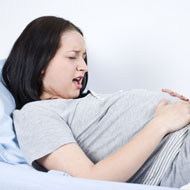- General Articles
- General Pregnancy Questions
- Baby Growth
- Pregnancy Diet
- Miscarriage
- During Pregnancy
- Twin Pregnancy
- Toddler Meals
- Home Remedies During Pregnancy
- Breastfeeding
- Pregnancy Week By Week
- Pregnancy Tests
- Ectopic Pregnancy
- Pregnancy Signs and Symptoms
- Pregnancy Stages
- Potty Training
- Fetal Development
- Preschooler
- Postpartum Depression
- Toddler Illness
- Baby Care
- After Pregnancy
- Molar Pregnancy
- During Delivery
- Beauty and Style
- Pregnancy Clothing
- Preconception
- Fertility
Inducing Labor During Pregnancy
Pregnancy labor signs generally begin with a lowering of the abdomen known as ‘lightening’ as the baby takes its position for birth. At this time, the baby is in an upside down position with its head resting on the mouth of the uterus. As the due date nears, the cervix begins to dilate in anticipation of child birth and the mucus plug from the cervix is released through the vagina either in the form of a blob of mucus or in the form of a thick discharge. This discharge may be blood streaked. Many women are known to experience a sudden urge to tidy up the house as well just before going into labor.
The onset of these pregnancy labor symptoms vary from woman to woman, with some experiencing them weeks ahead of time while others experiencing them just a few days prior to delivery.
As the time for delivery nears, expectant mothers experience contractions that increase in severity over a short period of time. These painful contractions occur at regular intervals and are mainly felt in the back.
Unlike ‘Braxton Hick’s’, labor contractions do not ease as the expectant mother moves or walks around. A gush of liquid through the vagina indicates true labor. This is the result of a ruptured amniotic sac as the uterus prepares to push out the baby through the cervix. Pregnancy labor pain and contractions increase manifold once the ‘water breaks’. It may also be accompanied by vaginal bleeding.
The mother has to be very careful when in labor as infection can spread to the baby once the protective amniotic sac is ruptured. If labor progresses very slowly or the baby seems to be in distress, the doctors may have to resort to inducing labor in order to minimize the chances of pregnancy complications and infection being passed on to the baby. An intravenous dose of the synthetic hormone Oxytocin to trigger uterine contractions or the application of prostaglandin gel to soften the cervix is the most common way of inducing labor. Walking up and down stairs and nipple stimulation are natural ways of inducing labor. If labor fails to progress, if the mother experiences heavy bleeding or other complications or if the baby is found to be in extreme distress, a C-section may become inevitable for the wellbeing of the mother and baby alike. Inducing labor during pregnancy may also become inevitable after 42 weeks of gestation, when the baby is overdue.
Read more articles from the During Pregnancy Category.



 7 Must-Haves Before Your Baby Arrives
7 Must-Haves Before Your Baby Arrives Bonding Games for Babies
Bonding Games for Babies DIY Baby Bath Towel Apron
DIY Baby Bath Towel Apron Common Late Pregnancy Fears
Common Late Pregnancy Fears